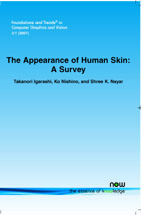The Appearance of Human Skin: A Survey
By Takanori Igarashi, Skin Care Research Laboratory, Kao Corporation, Japan, igarashi.takanori@kao.co.jp | Ko Nishino, Department of Computer Science, Drexel University, USA, kon@cs.drexel.edu | Shree K. Nayar, Department of Computer Science, Columbia University, New York, NY, nayar@cs.columbia.edu
Abstract
Skin is the outer-most tissue of the human body. As a result, people are very aware of, and very sensitive to, the appearance of their skin. Consequently, skin appearance has been a subject of great interest in various fields of science and technology. In particular, research on skin appearance has been intensely pursued in the fields of computer graphics, computer vision, cosmetology, and medicine. In this survey, we review the most prominent results related to skin in these fields and show how these seemingly disconnected studies are related to one another. In each of the fields, the optical behaviors of specific skin components have been studied from the viewpoint of the specific objectives of the field. However, the different components of skin produce different types of optical phenomena that are determined by their physio-anatomical characteristics (sizes, shapes, and functions of the components). The final appearance of skin has contributions from complex optical interactions of many different skin components with light. In order to view these interactions in a unified manner, we describe and categorize past works based on the physiological and anatomical characteristics of the various skin components.
The Appearance of Human Skin
Skin is the outer-most tissue of the human body. As a result, people are very aware of, and very sensitive to, the appearance of their skin. Skin appearance has, consequently, been a subject of great interest in various fields of science and technology. In particular, research on skin appearance has been intensely pursued in the fields of computer graphics, computer vision, cosmetology, and medicine.
The Appearance of Human Skin: A Survey reviews the most prominent results related to skin in these fields and shows how these seemingly disconnected studies are related to one another. In each of the fields, the optical behaviors of specific skin components have been studied from the viewpoint of the specific objectives of the field. However, the different components of skin produce different types of optical phenomena that are determined by their physioanatomical characteristics (sizes, shapes and functions of the components). The final appearance of skin has contributions from complex optical interactions of many different skin components with light.
In order to view these interactions in a unified manner, The Appearance of Human Skin describes and categorizes past works based on the physiological and anatomical characteristics of the various skin components. One of the major goals of skin research is to develop a precise and yet computationally efficient model of skin appearance. The Appearance of Human Skin surveys the many important results that have brought us closer to achieving this goal. However, it also highlights the many important and challenging problems that remain unsolved and need to be addressed. It will be of interest to anybody researching, or planning to conduct research, on the appearance of human skin.
